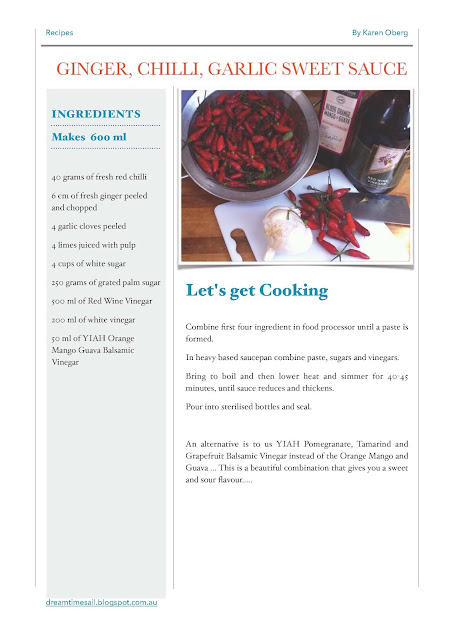10 Easy Techniques to Preserve Foods on your Boat
 |
| Its always handy to have dehydrated produce onboard. It extends your times between provisioning. |
 |
| Biges are made for cold storage. Just make sure you rotate produce often |
 |
| With the knowledge on smoking, cryovac sealing and freezing we had many options on preserving this fish for many months. |
 |
| Pickling foods is so satisfying and they have so many uses in the galley |
 |
| When provisioning for long haul sailing we cryovac everything that goes into the freezer it stops freezer burn and produce lasts longer |
Here are a couple of recipes for you to try:
Pickling is the process of preserving or expanding the lifespan of food by either anaerobic fermentation in brine or immersion in vinegar.
In my experience, there is no fence sitting in the gherkin debate. You either love them or hate them. While Josh falls very firmly into the haters category I am a ‘can’t get enough ...... I love them with cheese I love them with meats I will just eat them straight from the bottle. One of my favourite lunches growing up was the "Ploughman's Lunch" a ploughman's lunch is not complete without pickles. Cool, briny pickles straight from the fridge are one of the simplest pleasures of summer. Quick pickling is also a brilliant solution for preserving a plethora of vegetables from the market or your garden.
Pickles taste amazing! You can pickle pretty much any veggie, not just cucumbers: tomatillos, carrots, okra, beets, peppers, turnips, avocado. So grab some veggies, vinegar, a few spices and follow this bare bones easy recipe, you can also add pickling spices such as coriander and mustard seeds, peppercorns, and a bay leaf. Always delicious, but not mandatory. Whatever tickles your pickle.
Dig out your two biggest cooking pots — one for preparing the pickled vegetables and another for the sterilising process. You'll want to use the larger pot for boiling and sealing the jars. One 2cm of water should keep the jars covered at all times.
Ingredients
1 kg gherkins
1/4 cup plain salt not iodised
2 cups white vinegar
2 cups water
Pickling spice
Fresh dill
You can also add other vegetables that you fancy ... I love Sweet peppers, onions, radish and garlic in my pickle mix.
Pickling Spice
2 tablespoons whole mustard seeds
1 tablespoon whole allspice berries
2 teaspoons whole coriander seeds
1 teaspoon red pepper flakes, or more to taste
1 teaspoon ground ginger
2 bay leaves, crumbled
2 cinnamon sticks, broken in half
6 whole cloves
Lets get Cooking
Tie Pickling Spice into a muslin cloth.
Wash, pat dry and trim the gherkins at both ends, then place them in a large clean bowl/tray, sprinkle on the salt and store in a cool place until the salt has liquidised (a few hours)
When you are ready to go, bring to the boil the water and vinegar. Once boiling add pickling spice in muslin cloth and simmer for 5 minutes.
Rinse the gherkins with boiling water, drain and then rinse again. Put the gherkins (and other vegetables of choice) into hot jars that have been sterilised and add fresh dill.
Fill the jars almost to the top with the water/vinegar liquid and run a knife around inside the jar to get rid of any air bubbles. Top up the jar with liquid until it is just overflowing and using a cloth (as the jars will be very hot) tightly screw on the lids.
Wipe down the jars and leave to cool on the bench.
Gherkins will be ready in around three weeks. Put the jar in the fridge for a few hours to cool before eating.
Get creative! Pickling provides great opportunity to play with a variety of herb, spice, and flavour combos. Blend together a few favourites to create your own pickling recipe others will envy. Just keep in mind that herbs like celery seed, turmeric, and garlic pack a heavy punch, so integrate them gingerly. Always taste your spice mixture and pickling liquid before bottling, and remember that flavours continue to age and marinate after the jars are sealed.
1 tablespoon whole allspice berries
2 teaspoons whole coriander seeds
1 teaspoon red pepper flakes, or more to taste
1 teaspoon ground ginger
2 bay leaves, crumbled
2 cinnamon sticks, broken in half
6 whole cloves
Affiliate Program Statement
The following site is Our Galley-Dreamtimesail MyStore. These are items we use on Our Dreamtime or have researched as items we think are brilliant for life onboard. Looking at these products is free. However if you purchase an item through this link we will get a small commission to help us towards our “Sailing Kitty“ dollars. We have tried to find the best prices for the quality products we use ..... who doesn’t love a bargain! Dreamtimesail-OurGalley MyStore













This comment has been removed by a blog administrator.
ReplyDeleteThis comment has been removed by a blog administrator.
ReplyDeleteThanks for sharing this information with us.
ReplyDeleteDaphne thank you for reading my blog and taking the time to comment Cheers Karen
Delete